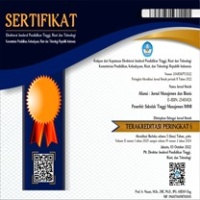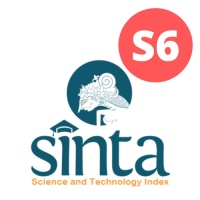SERVANT LEADERSHIP AS A DIFFERENTIATOR IN INDONESIAN REGIONAL DEVELOPMENT BANK
Abstract
Keywords
Full Text:
PDFReferences
Abid, Haider Raza, Amir Gulzar Foundation and Waqar Hussain. (March 2015). The impact of servant leadership on organizational citizenship behaviors with the mediating role of trust and moderating role of group cohesiveness: A Study
of public Sector of Pakistan. International Journal of Academic Research in Business and Social Sciences, Vol. 5, No. 3.
Armstrong, Michael. (2008). Strategic Human Resources Management. London: Kogan Page.
Barney, Jay B. and Patrick M. Wright. (Spring 1998). On Becoming A Strategic Partner: The Role of Human resources in Gaining Competitive Advantage. Human Resource Management, (1986-1998); Vol 37, No. 1.
Bass, B. M. (1985). Leadership: good, better, best. Organizational Dynamics, Vol. 13, No. 3, 26-40.
Boyer, G. B. (1999). Turning points in the development of male servant-leaders.
Unpublished doctoral dissertation, The Fielding Institute.
Carsten, M. K., Bien, M. U, West, B. J., Patera, J. L., and McGregor, R. (2010). Exploring social constructions of followership: A qualitative study. The Leadership Quarterly, Vol. 2, No. 3.
Checkland, Peter and John Poulter. (2006). Learning for Action: A Short Definitive Account of Soft Systems Methodology and its use for Practitioners, Teachers, and Students. England: John Wiley & Sons Ltd.
Dessler, Gary. (2015). Human Resources Management, 14th Ed., Essex: Pearson
Education Limited.
Ehrhart, M. G. (2004). Leadership and procedural justice climate as antecedents of unit level organizational citizenship behavior. Personnel Psychology, Vol. 57 No. 1, 61-94.
Greenleaf, R. K. (1977). Servant leadership: A journey into the nature of legitimate power and greatness. New York: Paulist Press.
Greenleaf, R. K. (2002). Servant Leadership: A Journey into the Nature of Legitimate Power and Greatness, 25th Anniversary Ed., New York: Paulist Press.
Greenleaf, R.K. (2008). The servant as leader. Westfield: Greenleaf Center for Servant Leadership.
Hall, Bradley W. (2008). The New Human Capital Strategy, New York: Amacom.
Hardjosoekarto, Sudarsono. (2012). Soft Systems Methodology (Metodologi Serba Sistem Lunak), Jakarta: UI Press-Lab Sosio Pusat Kajian Sosiologi.
Hitt, Ireland and Hoskisson. (2009). Strategic Management: Competitiveness &
Globalization, Boston: Harvard Business School Publishing.
Kaplan, David P. and Robert S. Norton. (2006). Alignment, Boston: Harvard Business School Publishing Corporation.
Laub, J. (2003). From paternalism to the servant organization: Expanding the Organizational Leadership Assessment (OLA) model. Paper presented at The 2003 Proceedings of the Servant Leadership Research Roundtable at Regent University, Virginia Beach, VA.
LSPP. (2014). Strategi Sukses Bisnis Bank Modul Sertifikasi Tingkat III General Banking, Jakarta: Gramedia dan Ikatan Bankir Indonesia.
McKay, Judy and Peter Marshall. (2001). The Dual Imperatives of Action Research, Information Technology & People, Vol. 14, No. 1, 46-59.
Mathur Garima, and Pushpa Negi. (June-August 2014). Servant Leadership and Organizational Citizenship Behaviour Among Employees of Service Sector. American International Journal of Research in Humanities, Arts and Social Sciences, Vol. 7, No. 2, 191-196.
Mira, W. S. and Margaretha. M. (May 2012). Pengaruh Servant Leadership Terhadap Komitmen Organisasi Dan Organization Citizenship Behavior. Jurnal Manajemen, Vol. 11, No. 2, Universitas Kristen Maranatha.
Neuschel, Robert P. (2005). The Servant Leader: Unleashing the Power of Your People. North Western University Press.
Patterson, K. (2003). Servant leadership: A theoretical model (Doctoral dissertation). Available from ProQuest Dissertations and Theses database. (UMI No. 3082719)
Senge, P. M. (1995). Robert Greenleaf’s Legacy: A new foundation for twenty-first century institutions, Reflection on leadership: How Robert K. Greenleaf ’s theory of servantleadership influenced today’s top management thinkers. New York: John Wiley & Sons, Inc.
Sims, B. J. (1997). Servant-hood: Leadership for the group effectiveness. Pennsylvania: The Wharton School, University of Pennsylvania.
So-Jung Kim, Kyoung-Seok Kim, and Yeong-Gyeong Choi. (2014). A Literature Review of Servant Leadership and Criticism of Advanced Research. World Academy of Science, Engineering and Technology International Journal of Social, Behavioral, Educational, Economic, Business and Industrial Engineering, Vol. 8, No. 4
Spears, L. (2010). Character and servant leadership: Ten characteristics of effective, caring leaders. The Journal of Virtues & Leadership, Vol. 1, No. 1, 25-30.
Shekari, Hamideh and Mahmood Zare Nikooparvar. (January 2012). Promoting Leadership Effectiveness in Organizations: A Case Study on the Involved Factors of Servant Leadership, International Journal of Business Administration, Vol. 3, No. 1
Taylor, T., Martin, B. N., Hutchinson, S., and Jinks, M. (2007). Examination of leadership practices of principals identified as servant leaders. International Journal of Leadership in Education, Vol. 10, No. 4, 401–419.
Ulrich, Dave. (1997). Human Resources Champion. Boston: Harvard Business School Press.
Ulrich, Dave, Wayne Brockbank, Justin Allen, Jon Younger, Mark Nyman Dani Johnson, Kurt Sandholtz, and Jon Younger. (2009). HR Transformation: Building Human Resources from the Outside In. New York: The RBL Institute & The McGrawHill Company.
Ulrich, Dave, Justin Allen, Wayne Brockbank, Jon Younger, Mark Nyman. (2009). Transformation: Building Human Resources from the Outside In. New York: The RBL Institute-McGraw-Hill.
Ulrich, Dave and Wendy Ulrich. (2010). The Why of Work: How Great Leaders Build Abundant Oganizations that Win. New York: The McGraw-Hill Company.
DOI: https://doi.org/10.46975/aliansi.v13i1.11
Refbacks
- There are currently no refbacks.
Copyright (c) 2020 Stefanus MS Sadana

This work is licensed under a Creative Commons Attribution 4.0 International License.
ISSN : 2541-545X
Published by:
Universitas Mitra Bangsa
Jl. Tanjung Barat No. 11 Jakarta Selatan
Telp: (021) 7817823 Fax: (021) 7815144
Website: https://umiba.ac.id/











